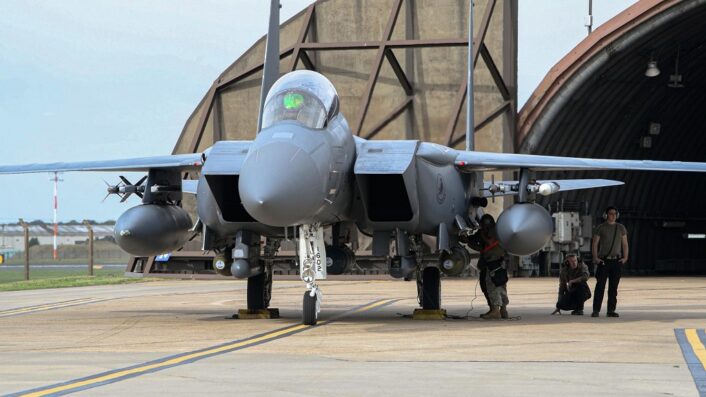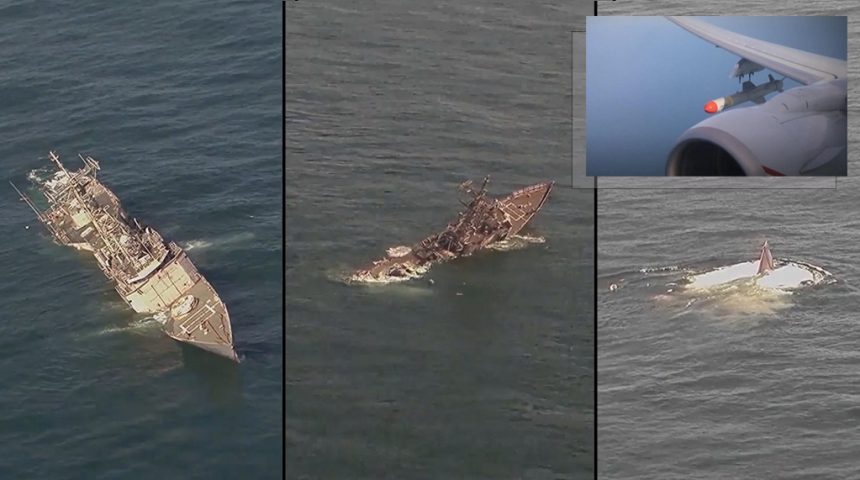The sinking of the decommissioned USS Boone saw in action, for the first time, many offensive capabilities, like the Quicksink bomb and the SM-6 missile in the anti-ship role.
On September 7, 2022, a SINKEX (Sink Exercise) took place in the northern Atlantic Ocean, off Scotland’s northwest coast. The exercise, called Atlantic Thunder 2022, was a joint, multi-phase, multinational exercise designed to increase NATO interoperability and strengthen the United States-United Kingdom strategic partnership, which culminated in a coordinated time-on-target strike of the decommissioned Oliver Hazard Perry Class frigate USS Boone.
“Sinking exercises not only provide excellent opportunities to gain real world operational experience in long range maritime strikes but also demonstrate the collective power of our combined forces,” said Rear Adm. Oliver “Ollie” Lewis, U.S. Naval Forces Europe-Africa’s (NAVEUR-NAVAF) Director of Maritime Operations. “Most importantly, gaining real world proficiency in the tactics, techniques and procedures we have developed and tested alongside our British Allies not only validate our weapons systems but ultimately contribute to NATO alliance readiness.”
The exercise was the first of its type for the Royal Navy in 18 years and also one of the rare instances when this happened in the Atlantic Ocean, as most SINKEX operations happen in the Pacific Ocean. As mentioned in the Royal Navy’s press release, it was a rare live test of complex weapons against a realistic target far out to sea and tested the power and accuracy of naval and air forces, giving allies real-world experience of hitting targets at sea from long range and proving the capability of several advanced warfighting and targeting techniques.
However, the exercise wasn’t only about sinking an old ship, but it was used to gather vital data that will help understand the effects of the weapons on the ship both to find better ways to destroy an enemy ship and improve the survivability of friendly ships. In fact, during the SINKEX, pre-placed instruments, sensors, and gauges transmitted real-time ship damage information, which were fed into the modeling software that analysts then use to predict internal damage from a variety of weapon effects and determine how that damage could affect mission capability.
Various assets collaborated on the Hebrides Deep Sea Range in order to sink the decommissioned USS Boone. Among the assets that joined the exercise were a U.S. Navy P-8 Poseidon from Patrol Squadron Nine (VP-9), the Royal Navy’s HMS Westminster and its AW159 Wildcat helicopter, three Royal Air Force Typhoons of the 41st Squadron, one U.S. Air Force F-15E Strike Eagle of the 494th Fighter Squadron, the USS Arleigh Burke and an unspecified U.S. Navy submarine. Additionally, range clearance safety was provided by other U.S. P-8As from VP-9’s sister squadron, VP-46.
Atlantic Thunder 2022 proved to be a rousing success for all participants, as it not only accomplished all of its primary objectives and sunk the decommissioned USS Boone, but according to the UK’s after action report, the process “achieved several firsts for the U.K. and U.S. in terms of advanced warfighting techniques and delivering complex weapon effects against a realistic target.” Ultimately, the ship formerly known as the USS Boone stood no chance against the “remarkable amount of combined firepower within a short period.”

First to hit the ex-Boone was a Standard Missile 6 (SM-6), courtesy of the guided-missile destroyer USS Arleigh Burke (DDG 51). The U.S. Navy confirmed this was the first anti-ship SM-6 engagement in the U.S. European Command area of responsibility. The SM-6, also designated Standard Extended Range Active Missile, greatly expands the AEGIS Weapon System battlespace. SM-6 provides not only an extended range anti-air warfare capability, but also an anti-surface warfare capability to be expressed against enemy ships.
The SM-6 attack was followed in short order by the coordinated Harpoon shot conducted by the Poseidon and the HMS Westminster. The two missiles fired by the Type 23 frigate were the first live RGM-84D Harpoon missile salvo from the UK since 2004. As mentioned by VP-9, at precisely 15:21 Zulu, the AGM-84D Harpoon launched from the P-8A had a rendezvous with two surface launched Harpoons into the hull of the ex-Boone, resulting in 660 kg (1500 lb) of high explosive striking the ship simultaneously.
The HMS Westminster’s portion of coordinated time on target strike included passive over-the-horizon-targeting generated by U.S. Naval Integrated Fires (NIFE), marking the first time this type of targeting has ever been accomplished against a real life target with multinational collaboration. Raymond O’Toole, Principle Deputy Director, Operational Test and Evaluation from the Office of the Secretary of Defense remarked on this coordinated targeting, stating, “What we’ve demonstrated through this exercise is a new capability–to gain and exchange information for targeting purposes.”
3 Typhoons, @RoyalNavy & @USNAVY used an array of high-powered weaponry for simulated attacks on the decommissioned frigate, USS Boone.
Full story: https://t.co/RzGF0vj0qd pic.twitter.com/myGx4568Rm
— Royal Air Force (@RoyalAirForce) September 23, 2022
Following the Harpoon strike, three RAF Typhoon FGR4 fighter jets arrived on scene. The aircraft dropped four Paveway IV laser-guided bombs, the first time ever RAF Typhoons employed live ordnance onto a warship used as a maritime target. The HMS Westminster’s Wildcat helicopter provided target designation and lasing for the bombs with its MX-15 electro-optical/infrared sensor turret, which was also another first.
“Direct hit, good effect on target!”
An 847 NAS Forward Air Controller (Airborne) provides terminal guidance from a Wildcat HMA of @815NAS onboard @HMS_Westminster to a 500lb Paveway IV launched by @41RTES Typhoon as part of Ex Atlantic Thunder 22. @RoyalNavy @RoyalAirForce pic.twitter.com/nHxXuexaWf
— 847 Naval Air Squadron (@847NAS) September 23, 2022
The AW159 Wildcat then launched two Martlet missiles air-to-surface missiles into the Boone’s hull. This was the first firing of the Fleet Air Arm’s new anti-ship weapon against a realistic target at sea – to this point Martlet had only been used against purpose-built targets. The Martlet missile, also known as the Lightweight Multirole Missile, is an air-to-surface and surface-to-surface missile for use against small surface vessels, which offers a unique capability to defeat asymmetrical and terrorist threats in the littoral environment. The Wildcat can fly with up to 20 Martlet missiles, as each of them only weighs 13 kg (but can still provide an engagement range of more than 6 km).
Next in line to attack the former USS Boone was the F-15E Strike Eagle from RAF Lakenheath. The press releases only mentioned the employment of two Joint Direct Attack Munitions (JDAM) by the F-15E, however the photos from 48th Fighter Wing Public Affairs on DVIDS clearly show the aircraft armed with three GBU-31 Quicksink bombs. These bombs are modified 2,000-pound GBU-31s developed as a new low-cost, air-delivered smart weapon capability intended to defeat maritime threats, which have been tested for the first time last year.
The exercise was closed by the sub-launched munition and Explosive Ordnance Disposal live charges which delivered the final blow against the ex-Boone, sending her to the depths of the North Atlantic in over 6,500 feet of water. In order to mitigate potential adverse effects and keep risk to the environment as low as practicable, the ship was prepared and configured specifically to meet stringent Environmental Protection Agency (EPA) standards.
“Ex Atlantic Thunder has demonstrated that U.K. and U.S. naval and air forces can integrate to deliver an end-to-end kill chain against a maritime target at long range,” said Cmdr. Ed Moss-Ward, commanding officer of HMS Westminster. “The integration of high end weapons, sensors and communications with our NATO allies is key to the collective war fighting capability of the Alliance demonstrated by the sinking exercise. The firings have supported the development of the Royal Navy’s targeting and weapon capabilities, and afforded opportunity to conduct realistic training to validate tactics and operating procedures.”
The exercise might also send a message to adversaries, especially given the current tensions with Russia and China, as the US, UK and NATO forces prepare again for near peer adversaries and great power competition. This kind of capabilities will be vital in operational theaters like the Pacific Ocean, where naval forces will subject to the confrontation with other navies and have to be prepared to strike enemy naval targets and be lethal.
“What we’ve seen in Atlantic Thunder today, is that with Royal Air Force, U.S. Air Force, U.S. Navy, and Royal Navy all operating together [with] helicopters, fixed-wing aircraft, ships, and a submarine, every one of which is capable of going to war tomorrow, we’ve proven it today for the first time in decades in the Atlantic,” said U.K. Royal Navy Director Develop Rear Adm. James Parkin. “What we’ve bought works, how we work together has gotten better, and there’s huge opportunity to work even closer together in the future to make it not just an exercise, but just a way of thinking, and a way of life.”
Ex-Boone is a decommissioned guided missile frigate, which entered United States Naval service, May 15, 1982. It was decommissioned on Feb. 23, 2012. The twentieth ship of the Oliver Hazard Perry class, it was the first ship named for Vice Admiral Joel Thompson Boone, a Medal of Honor recipient and the most highly decorated medical officer during World War I.









